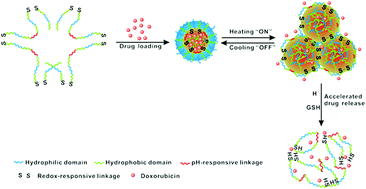On–off switchable drug release from multi-responsive degradable poly(ether urethane) nanoparticles†
Abstract
A novel on–off switchable

* Corresponding authors
a
Key Laboratory of Functional Polymer Materials of MOE, Institute of Polymer Chemistry, Nankai University, Tianjin 300071, P. R. China
E-mail:
guolinwu@nankai.edu.cn
Fax: +86 22 23502749
Tel: +86 22 23507746
b
School of Chemistry and Chemical Engineering, Tianjin University of Technology, Tianjin 300191, P. R. China
E-mail:
jbma@tjut.edu.cn
Fax: +86 22 23502749
Tel: +86 22 23507746
A novel on–off switchable

 Please wait while we load your content...
Something went wrong. Try again?
Please wait while we load your content...
Something went wrong. Try again?
Y. Wang, G. Wu, X. Li, Y. Wang, H. Gao and J. Ma, Biomater. Sci., 2013, 1, 614 DOI: 10.1039/C3BM00188A
To request permission to reproduce material from this article, please go to the Copyright Clearance Center request page.
If you are an author contributing to an RSC publication, you do not need to request permission provided correct acknowledgement is given.
If you are the author of this article, you do not need to request permission to reproduce figures and diagrams provided correct acknowledgement is given. If you want to reproduce the whole article in a third-party publication (excluding your thesis/dissertation for which permission is not required) please go to the Copyright Clearance Center request page.
Read more about how to correctly acknowledge RSC content.
 Fetching data from CrossRef.
Fetching data from CrossRef.
This may take some time to load.
Loading related content
